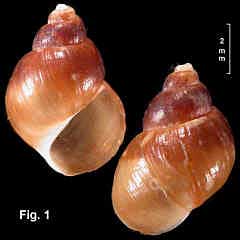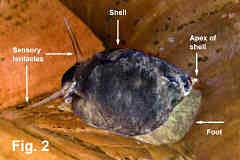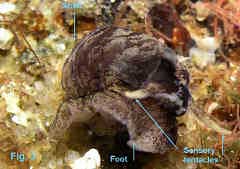|
|
|
|
|
Alexania moerchi (Adams & Angas, 1864) (NEW COMBINATION) Description: Shell lightweight, semi-translucent, aperture ½ length of shell, with thin, fawn periostracum. Protoconch of about 2 smooth, rounded whorls, ending with low varix. Teleoconch suture deep, whorls rounded, smooth apart from axial growth lines. Aperture large; outer lip thin. Umbilicus closed, or a narrow slit beside inner lip of aperture. Colour of early whorls dark brown, last whorl brown above periphery, fawn below. Operculum corneous. Size: Up to 11 mm in length. Distribution: Known from Australia and Japan. In Australia; Moreton Bay, Queensland, southwards to Botany Bay, NSW. Habitat: This species has been found in the interstices of clumped sandy tubeworms (Galeolaria cespitosa) on exposed mid-tidal rocks on the rocky reef platform at Hastings Point, NSW (R. Willan, pers. comm.). It has also been reported in the Brunswick River, under rocks on rock walls at the mid to low tide level, with eggs (D. Riek, pers. comm.). In this latter habitat, which has a strong tidal flow, it was attached to rocks with a mucous thread. Synonymy: Habea inazawai Kuroda, 1943 is a synonym (NEW SYNONYM), based on comparison of 15 shells with the original description of H. inazawai, and with the figures given by Okutani (2000, p. 342). Remarks: There has been uncertainty of the family and genus for this species for a long time. It was originally described in the Naticidae, then transfered to Littorinidae , and latterly to Epitonidae (Wilson, 1993, p. 280). However, in the original description of Habea inazawai in 1943, Kuroda stated that anatomical examination placed it in the Epitoniidae. Fig. 1: Middle Harbour, NSW. Protoconch missing. (C.032543) Figs. 2, 3: Live animal. Brunswick River, NSW (Photos D. Riek) |


